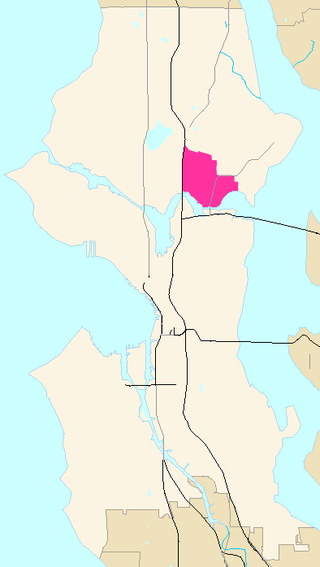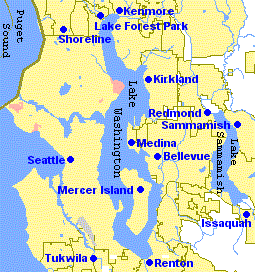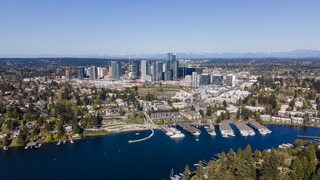
The Century 21 Exposition was a world's fair held April 21, 1962, to October 21, 1962, in Seattle, Washington, United States. Nearly 10 million people attended the fair during its six-month run.

Haller Lake is a small lake and neighborhood in north central Seattle, Washington, named for Theodore N. Haller, who platted the neighborhood in 1905. His father, Granville O. Haller, was one of Seattle's early settlers, an army officer who amassed a large estate in the region.

The University District is a major district in Seattle, Washington, comprising several distinct neighborhoods. The main campus of the University of Washington (UW) is located in the district, lending its name to both the district as well as University Way NE.

Seattle Center is an entertainment, education, tourism and performing arts center located in the Lower Queen Anne neighborhood of Seattle, Washington, United States. Constructed for the 1962 World's Fair, Seattle Center's landmark feature is the 605 ft (184 m) Space Needle, an official city landmark and globally recognized symbol of Seattle's skyline. Other notable attractions include the Pacific Science Center, Climate Pledge Arena, and Museum of Pop Culture (MoPOP), as well as McCaw Hall, which hosts both the Seattle Opera and Pacific Northwest Ballet. The Seattle Center Monorail provides regular public transit service between Seattle Center and Westlake Center in Downtown Seattle, and is itself considered a tourist attraction.

Pacific Science Center is an independent, non-profit science center in Seattle with a mission to ignite curiosity and fuel a passion for discovery, experimentation, and critical thinking. Pacific Science Center serves more than 1 million people each year at its campus adjacent to Seattle Center, at the Mercer Slough Environmental Education Center in Bellevue, Washington, and in communities and classrooms across the state of Washington.

West Seattle is a conglomeration of neighborhoods in Seattle, Washington, United States. It comprises two of the thirteen districts, Delridge and Southwest, and encompasses all of Seattle west of the Duwamish River. It was incorporated as an independent town in 1902 before being annexed by Seattle five years later. Among the area's attractions are its saltwater beach parks along Elliott Bay and Puget Sound, including Alki Beach Park and Lincoln Park. The area is also known for its views of the Olympic Mountains to the west and the Cascade Range to the east. One-third of Seattle's green space and urban forest is located in West Seattle, much of it in the West Duwamish Greenbelt.

The Burke Museum of Natural History and Culture is a natural history museum in Seattle, Washington, in the United States. Established in 1899 as the Washington State Museum, it traces its origins to a high school naturalist club formed in 1879. The museum is the oldest in Washington state and boasts a collection of more than 16 million artifacts, including the world's largest collection of spread bird wings. Located on the campus of the University of Washington, the Burke Museum is the official state museum of Washington.

The Eastside of the King County, Washington area in the United States is a collective term for the suburbs of Seattle located on the east side of Lake Washington.

Occidental Park, also referred to as Occidental Square and Occidental Mall, is a 0.6 acre public park located in the Pioneer Square district of Seattle, Washington.

Camp Harmony is the unofficial euphemistic name of the Puyallup Assembly Center, a temporary facility within the system of internment camps set up for Japanese Americans during World War II. Approximately 7,390 Americans of Japanese descent from Western Washington and Alaska were sent to the camp before being transferred to the War Relocation Authority camps at Minidoka, Idaho, Tule Lake, California and Heart Mountain, Wyoming.

Washington's 9th congressional district encompasses a long, somewhat narrow area in Western Washington, through the densely populated central Puget Sound region, from Auburn and Federal Way in the south to parts of Seattle and Bellevue in the north. Since 1997, the 9th district has been represented in the U.S. House of Representatives by Adam Smith, a Democrat from Bellevue.
Seattle Rep is a major regional theater located in Seattle, Washington, at the Seattle Center. It is a member of Theatre Puget Sound and Theatre Communications Group. Founded in 1963, it is led by Artistic Director Dámaso Rodríguez and Managing Director Jeffrey Herrmann. It received the 1990 Regional Theatre Tony Award.

Project Infinity is the second full-length studio album by Man or Astro-man?. The cover is a reworking of Attilio Mineo's Man in Space with Sounds, which was used as the soundtrack to the futuristic "Bubbleator" exhibit at the 1962 Century 21 Exposition.

The Seattle-Tacoma Shipbuilding Corporation was an American corporation which built escort carriers, destroyers, cargo ships and auxiliaries for the United States Navy and merchant marine during World War II in two yards in Puget Sound, Washington. It was the largest producer of destroyers (45) on the West Coast and the largest producer of escort carriers of various classes (56) of any United States yard active during World War II.

Ye Olde Curiosity Shop is a store founded in 1899, on the Central Waterfront of Seattle, Washington, United States. It is currently located on Pier 54. Best known today as a souvenir shop and museum, it also has aspects of a dime museum, and is an important supplier of Northwest Coast art to museums. As of 2008, the store has been owned by four generations of the same family.

Downtown Bellevue is the central business district of Bellevue, Washington, United States. It is bounded by I-405 to the east, NE 12th Street to the north, 100th Ave NE to the west, and Main Street to the south, and covers an area of around 400 acres (160 ha). It is the second largest city center in Washington state, with more than 50,000 employees and 12,000 residents. Geographically centered near the heart of the Puget Sound region, downtown Bellevue is a regional growth center offering over 9 million square feet (840,000 m2) of Class A office space, various major retail and entertainment locations, more than 2,500 hotel rooms and almost 10,000 housing units.
The Working Waterfront Maritime Museum is a Maritime Museum located in Tacoma, Washington, USA. The museum sits on the Thea Foss Waterway. Along with the Discovery Wharf Children's Activity Area, the WWMM is a part of the Foss Waterway Seaport, a 501c3 non-profit organization founded in 1996. In conjunction with the Foss Waterway Development Agency, the Seaport seeks private and public funds to support its mission statement. The Working Waterfront Maritime Museum is dedicated to creating "a permanent education and activity venue on the Tacoma waterfront".

Shelly's Leg was the first openly operated gay bar in Seattle. It operated from 1973 until sometime c. 1978.

The Amazon Spheres are three spherical conservatories comprising part of the Amazon headquarters campus in Seattle, Washington, United States. Designed by NBBJ and landscape firm Site Workshop, its three glass domes are covered in pentagonal hexecontahedron panels and serve as an employee lounge and workspace. The spheres, which range from three to four stories tall, house 40,000 plants, as well as meeting space and retail stores. They are located adjoining the Day 1 building on Lenora Street. The complex opened to Amazon employees and limited public access on January 30, 2018. The spheres are reserved mainly for Amazon employees, but are open to the public through weekly headquarters tours and an exhibit on the ground floor.

Wall of Sound is a record shop on Seattle's Capitol Hill, in the U.S. state of Washington.

















